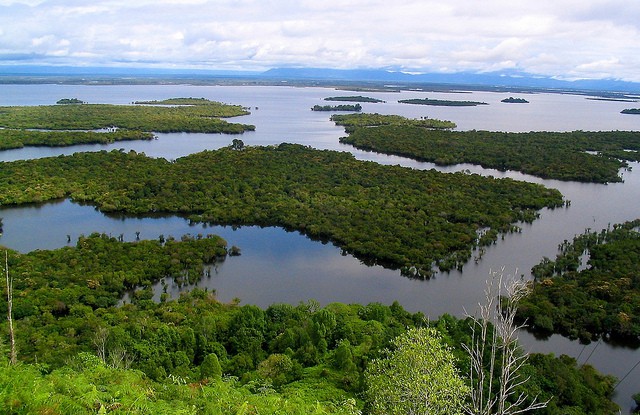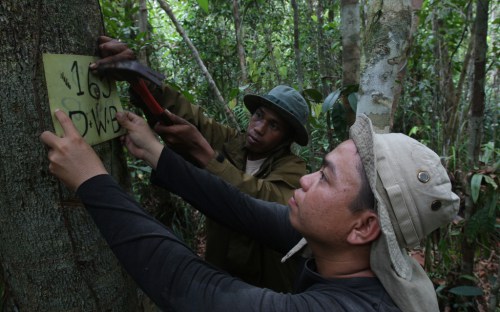
BOGOR, Indonesia — Whereas magicians use mirrors to make huge objects seemingly disappear, researchers in Indonesia are developing maps to “find” forests that apparently weren’t there before.
And the best part: It’s not an illusion.
By developing a more detailed map, researchers have shown that watershed-protection forest in Maluku province occupies more than double the area previously believed — a discovery with profound implications for land planners.
But now that local and provincial governments have bought into the new map, the real trick will be to persuade the national government to join them.
These findings are all part of a four-year research and development project known as CoLUPSIA, which stands for Collaborative land-use planning and sustainable institutional arrangement for strengthening land tenure, forest and community rights in Indonesia.
The multidisciplinary project, which focused on West Kalimantan and Central Moluccas (Maluku), wrapped up earlier this year. It was a partnership between the Center for International Forestry Research (CIFOR) and CIRAD (a French agency supporting agricultural research for development), two national and two local nongovernmental organizations (NGOs), and two local universities.
At the heart of CoLUPSIA is a shift from top-down to bottom-up spatial planning.
BLOWING IT UP
In the past, land-use planners in Indonesia have typically blown up large-scale provincial maps to visualize land issues on a district level. The results are not detailed enough to depict all the vegetation and topography—meaning that planning decisions are not based on the most accurate data.
Spatial planning—which brings together conservation, land use and resource management, land allocation, tenure and governance—requires finer data, as it puts more attention on spatial patterns and distribution of land uses and resources.
“CoLUPSIA was all about showing government how much easier it would be to make decisions through spatial planning using appropriate scale,” said project leader Yves Laumonier, a CIFOR scientist. “For example, large-scale land suitability data and maps of the spatial planning process could identify where to allow oil palm plantations that would not harm the environment.”
The CoLUPSIA project shows that the resulting inequity and conflict could be resolved if governing bodies at national, regional and local scales are given more detailed data, and if resulting decisions made for these regions are made through collective discussion.
HEARING (LOCAL) VOICES
The project embraced participatory prospective analysis (PPA), a process that enabled stakeholders to collaborate at the district level toward a consensus for land and resource use. The group developed a spectrum of potential scenarios for future land use, and agreed to move towards the most desired scenario.
Communities, often ignored in land-use decision-making, were eager to participate in the process, both in collecting socioeconomic data and in reviewing implications of findings, researchers reported. Customary and village leaders, religious leaders, youth and women’s groups were all represented in the pilot villages.
It’s a complex process, and we still have a long way to go, but it seems like a necessary step to bring more equity in decisions made on spatial planning through collective discussion
Listening to a wide range of voices generated some surprises. “By taking data from all over the district, we saw different aspects of the issues,” Laumonier said. “We learned that not all local people are against oil palm. Communities are not encapsulated in a traditional, stubborn, conservative pattern of behavior.”
“They are open to change, especially if this means economic opportunities, but without a long-term collective vision about the management of natural resources, local communities are often placed in a weak position in front of third parties driven by pure economic interests.”
Local governments, too, embraced PPA. Since policy and legislation are typically developed at the national level, provincial and district governments can struggle to apply it in their own jurisdictions. The participatory process enabled lower levels of government to meet with local actors involved in spatial planning, and gain insight into their concerns. By building their knowledge and capacity, the project also empowered them to become “ambassadors” for the findings at the national level.
It was more difficult to engage the private sector in CoLUPSIA, Laumonier said. While the project organized regular meetings at the district and provincial level with oil palm companies, local industry representatives would often not take part in the meeting. Why? Because some were in collusion with local leaders.
“By working at the local level, we have identified many hidden issues,” Laumonier said. “The project recently exposed an illegal opening of a peat swamp that was supposed to be under moratorium. It is a huge area. Gradually, we understood the swamp conversion had the blessing of the district head, who had previously said he was concerned about the environment. It is an ecological disaster for that area with strong impact on the nearby Danau Sentarum national park.”
LOOKING MORE CLOSELY
In its four-year lifespan, CoLUPSIA generated findings around the value of larger-scale maps. Whereas conventional maps use a 1:250,000 scale, researchers produced maps with a 1:50,000 scale, which allowed much greater detail. Forest classified as watershed-protection area, for example, was found to occupy more than double the area previously believed.
“The larger scale gives a completely different picture, and often increases the ‘watershed protection’ class because of the more detailed data on slopes,” Laumonier said. “This has tremendous implications for land zoning.”
Apart from recording new types of forest and more than 1,500 tree species, the new land cover maps show more than 50 classes of vegetation types according to altitude and ecological condition. The combination of detailed land-mapping cover and participatory mapping with communities also identified all types of degradation, secondary regrowth and agriculture.
The study also shed light on perceptions of tenure security. In Kalimantan, Laumonier said, many villagers believe they own the land. But the government does not recognize all customary institutions, regulations are unclear, and local elites hold critical documents under lock and key.
“There is an implicit demand from communities to formalize their informal rights to protect their resources and avoid future conflicts,” Laumonier said. “But we need more evidence that land titling would be appropriate and feasible in Indonesia. Sometimes it can have negative effects.”
Results showed that villages had several strong local institutions, both governmental and customary, that could ensure sustainable forest management, secure access to land and forest, resolve conflicts and design lasting rules for forest use. These structures could help build bridges between communities and higher levels of authority, he said. For partnerships to flourish, however, ambiguities and contradictions in land-use planning and tenure laws must be resolved.
ONE MAP
Recently, through its “One Map Initiative,” the Indonesian government decreed that land-use maps should use the 1:50,000 scale at district level.
“Our work was extremely well received by local and provincial governments,” Laumonier said. “There is now an opening to get endorsement from the state because our map would be perfect for the One Map Initiative. It’s a complex process, and we still have a long way to go, but it seems like a necessary step to bring more equity in decisions made on spatial planning through collective discussion.”
For more information about the issues in this article, contact Yves Laumonier at y.laumonier@cgiar.org.
This project was funded in part by the European Commission and forms part of the CGIAR Research Program on Forests, Trees and Agroforestry.
We want you to share Forests News content, which is licensed under Creative Commons Attribution-NonCommercial-ShareAlike 4.0 International (CC BY-NC-SA 4.0). This means you are free to redistribute our material for non-commercial purposes. All we ask is that you give Forests News appropriate credit and link to the original Forests News content, indicate if changes were made, and distribute your contributions under the same Creative Commons license. You must notify Forests News if you repost, reprint or reuse our materials by contacting forestsnews@cifor-icraf.org.

